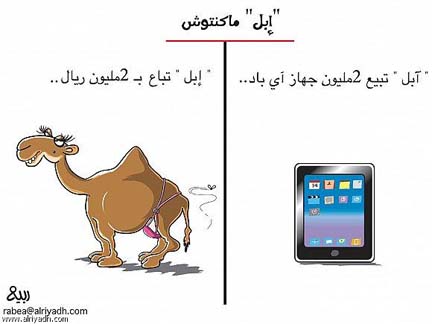
Category Archives: camels
Camel in the Post
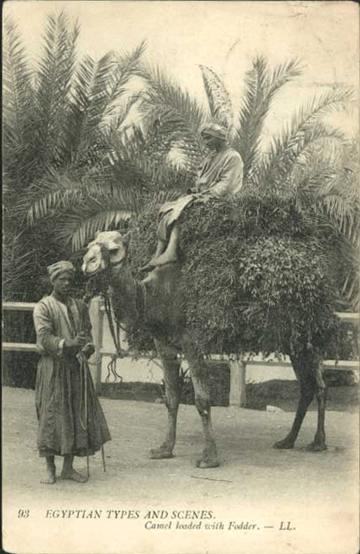
Postcard from about 1911
Where else would you find an Arab?
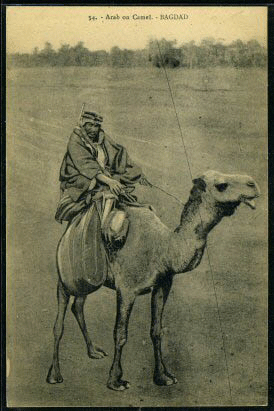
Here is a postcard from a century ago entitled “Arab on Camel … BAGDAD.” I guess for the postcard title writer, a camel rider outside the city of Baghdad might as well be down town. But one wonders why the title was even needed. Where else would the person receiving the postcard at the time have imagined an “Arab” would be?
Walk a Mile for a Chocolate Bar?
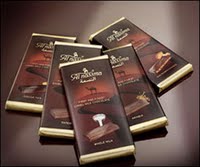
World’s First Camel-Milk Chocolates Going Global
Asharq Alawsat, July 22, 2009
DUBAI (Reuters) – Dubai’s Al Nassma, the world’s first brand of chocolate made with camels’ milk, is in talks to expand into new Arab markets, Europe, Japan and the United States, its general manager said Tuesday.
Martin Van Almsick said the United Arab Emirates company planned to enter Saudi Arabia first, followed by Bahrain, Qatar, Kuwait and the United States within the next few months.
Al Nassma is also in talks with British department store Harrods and San Francisco’s Chocolate Covered to sell its products.
Founded and owned by Dubai’s ruler Sheikh Mohammed bin Rashid al-Maktoum, Al Nassma was formally established in October last year and aims to produce 100 tons of premium camels’ milk chocolate a year. Continue reading Walk a Mile for a Chocolate Bar?
More than One Way to Skin on a Camel
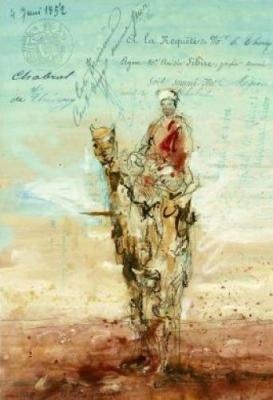
Bedouin sur son Dromadaire, Yann Letestu
“It is nothing short of amazing to find how many parts of one’s anatomy come into contact with a camel’s saddle and how quickly that same saddle removes the outer layers of one’s skin.â€
J. B. Mackie, “Hasa: an Arabian Oasis,†Geographical Journal 63:193, 1924.
Milking the Camel

One of the most common Orientalist tropes about the Middle East is the image of the camel, the ship of the desert. Bernard Lewis angered Edward Said by comparing one of the Arabic terms for revolution (thawra) to a camel’s rising, a point made in the old Arabic lexicons. But the camel strikes back on Sharjah Television. On the program “Medicine and Islam” the benefits of camel’s milk are spelled out, including some rather grand claims.
The video on Islamic Tube is accompanied by the following article from the Khaleej Times:
SHARJAH. A research body here is seeking global tie ups to produce drugs to treat deadly diseases including Aids from the unique antibodies found in camel`s milk. Continue reading Milking the Camel
Animal House in the 15th Century: Part 1
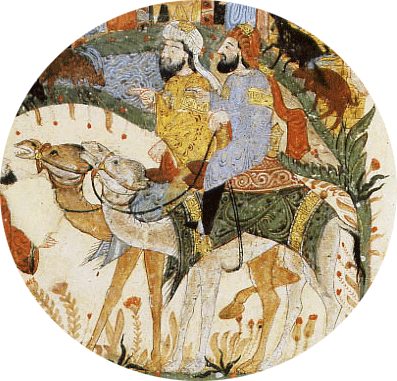
One of the most entertaining Arabic compendia on animal life, taken in the loose sense of the term for things that breathe or are thought to breathe, is the Hayât al-Hayawân (Life of Animals) of the Egyptian savant Kamâl al-Dîn Muhammad ibn Mûsâ al-Damîrî. Writing a century before Columbus discovered America, al-Damiri spins stories about animals with a variety of folklore about uses of animal products and parts. A scientist would no doubt shudder at the magical and literary focus of the text, only occasionally finding description useful today. A partial English translation was made by a British officer, Lieutenant-Colonel Jayakar, and published in two volumes in 1906 and 1908 in India. Unfortunately, this text is virtually inaccessible. I have looked at two copies, one in the New York Public Library and the other at the Library of Congress, and only with trepidation have I turned the fragile pages in this poorly bound volume. So far there is no digital version, which is a shame, since it is a delight to read.
Our author was a prolific copyist, quoting from over 800 other authors and providing a thousand entries, some simply an animal’s name and its more common synonym. Ironically, Jayakar’s Victorian sensitivity makes the translation as much an oddity as the primary work. Continue reading Animal House in the 15th Century: Part 1
Traveling Light in Arabia
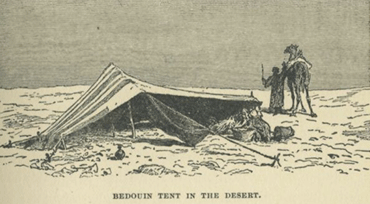
[Note: the following list of items for light camping in Arabia is provided by G. Wyman Bury for the early part of the 20th century.]
CAMP EQUIPMENT
Try to do without a tent. Arabs hate pitching tents after a long day’s march, and seldom pitch them well. They draw fire and afford no protection, while preventing your own observation; they also betray the site of your camp to bad characters and casual callers on the look out for supper.
BEDDING
Avoid Wolseley valises or anything with pleats and folds, which become the permanent abiding places of parasitic insects.
‘Blankets.’ One each for the men. A few extra for convalescents or invalided men. Two for yourself.
‘Pillows.’ Carry your spare clothes in a green canvas sack. Continue reading Traveling Light in Arabia